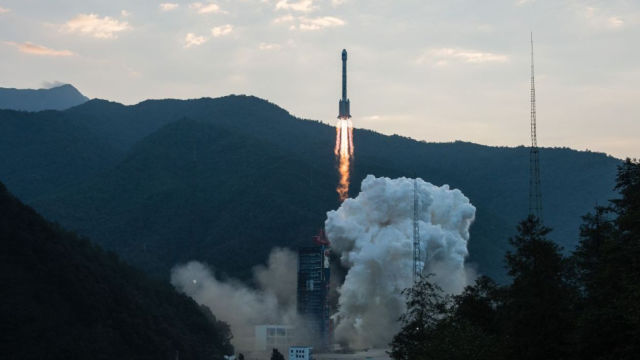TASS-DOSSIER. China launched from the Xichang cosmodrome (Sichuan Province) on May 30 A Long March 3B launch vehicle with a Pakistani communications satellite.
TASS has prepared a material about the space carrier.
Basic information
Long March 3B (LM-3B; other English name: Changzheng-3B) belongs to the family of Long March launch vehicles, named after the Great Campaign of the Chinese Communist Army of 1934-1936 - an operation to regroup detachments under the command of Mao Zedong.
The LM-3B rocket was developed by the Chinese Academy of Rocket Technology (eng. CALT), part of the Chinese Aerospace Science and Technology Corporation (CASC). The project for its creation was approved in February 1993.
Characteristics of the rocket
The LM-3B is a single-use three-stage medium-class launch vehicle. The propulsion systems of the first and second stages run on toxic heptyl (oxidizer - nitrogen tetraoxide). The first stage additionally uses four launch boosters. The third stage is equipped with an oxygen-hydrogen engine.
The height of the rocket is 55-56 m, diameter is 3.35 m, launch weight is up to 459 tons, maximum payload is 11.5 tons.
China uses the LM-3B to launch various spacecraft, including satellites of the national navigation system Beidou, automatic interplanetary stations.
Launch statistics and incidents
The launch vehicle is launched from the Xichang Cosmodrome, which is located in Sichuan Province in southwestern China.
The first launch of the LM-3B, undertaken on February 14, 1996, failed. The rocket exploded on the 20th second of the flight, six people from among the cosmodrome personnel died under its debris. As a result of the emergency launch, the American Intelsat-708 communications satellite was lost. During the next launch, which took place on August 19, 1997, the LM-3B rocket successfully launched the Philippine communications satellite Agila-2 into space.
The launch was partially successful on August 31, 2009, when, due to the abnormal operation of the third stage of the rocket, the Indonesian Palapa-D communications satellite could not be put into the calculated orbit. As a result, the spacecraft had to use its own engines to reach the desired altitude. A similar situation occurred on June 18, 2017, during the launch of the Chinese Zhongxing-9A satellite, designed for live radio and television broadcasting. He also adjusted his flight on his own.
The launch on April 9, 2020 was the second emergency in the history of the LM-3B operation. Due to a malfunction in the propulsion system of the third stage, the rocket was unable to gain the speed necessary to enter orbit. Its upper stage with the Indonesian communications satellite Palapa-N1 reached an altitude of about 170 km and then fell into the ocean.
In total, according to CASC, as of May 30, 95 launch vehicles were launched, including 2 unsuccessful and 2 partially successful. In particular, with the help of LM-3B, automatic interplanetary stations to the Moon were launched into space: in 2013, Chang'e-3 with the Yutu lunar rover, in 2018, Chang 'e-4 with a lander and a second Chinese lunar rover.
The previous launch using the LM-3B took place on May 9. Then the rocket launched the Chinese Smart SkyNet 1-01 satellite into low-Earth orbit, designed to test developments in the field of communications.

